|
|
|
Sort Order |
|
|
|
Items / Page
|
|
|
|
|
|
|
| Srl | Item |
| 1 |
ID:
172575
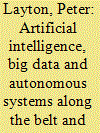

|
|
|
|
|
| Summary/Abstract |
China is pressing ahead with ambitious plans to create a massive infrastructure network connecting it with many countries across the globe. Some of the ‘belt and road’ infrastructure will however, run through regions convulsed by chronic civil unrest, substantial criminality and incipient insurgencies and need protection by China’s private security companies. Simultaneously the Chinese state is undertaking a major ‘anti-secession and counter-terrorism’ campaign in Xinjiang using a variety of high-technology means: artificial intelligence, big data, wireless connectivity, autonomous systems and robotics. The demand and supply sides seem to be in sync, suggesting Chinese private security companies will soon use a suite of advanced information technology systems with a proven employment doctrine across much of Central Asia, South Asia and Africa. Such a future may be plausible but it is by no means certain as various factors may yet thwart China’s private security companies.
|
|
|
|
|
|
|
|
|
|
|
|
|
|
|
|
| 2 |
ID:
146011
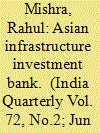

|
|
|
|
|
| Summary/Abstract |
Lauded as one of the most remarkable Chinese initiatives in the international financial arena, the Asian Infrastructure Investment Bank (AIIB) sets the stage for China’s greater role in the international economic system as a prominent stakeholder. Headquartered in Beijing, the bank is expected to play a key role in plugging the infrastructure gaps in Asia, which have been estimated at US$8 trillion between the years 2010 and 2020. The setting up of the AIIB will have far-reaching economic as well as politico-strategic implications for countries across Asia and beyond. While the AIIB has been seen as a remedy to address infrastructure deficit in Asia, it is unlikely to meet the US$8 trillion goal on its own. The biggest challenge before the bank, therefore, is to prioritise in terms of selecting projects so that it optimally utilises the available financial resources and functions as a transparent and impartial organisation, in addition to making a swift and smooth transition from a ‘Chinese initiative’ to a ‘China-led initiative’ that yields equitable benefits to all its member countries.
|
|
|
|
|
|
|
|
|
|
|
|
|
|
|
|
| 3 |
ID:
160467
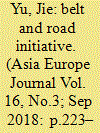

|
|
|
|
|
| Summary/Abstract |
This article explores the linkages between domestic affairs and foreign policies in China in fulfilling its grand ambition of Belt and Road Initiative (BRI). It examines the complexities in decision-making process of “BRI” inside Beijing’s administration. It departs from the most existing literature on BRI in Europe, which focus upon the geo-economic and geo-political impacts of the BRI. Instead, it adopts an “inside-out” approach by examining the actual policy process with a primary focus to individual actors such as the Party, the government department and the state-owned enterprises as well as individual academics. It also disentangles the intricate relations amongst the Party, the key decision-making institutions and the policy execution entities in determining the final outcome of the BRI. It will finally reflect the extent to which Beijing’s bureaucratic complexities have impacted upon the EU and its member states’ willingness in collaborating or in formally endorsing China’s BRI.
|
|
|
|
|
|
|
|
|
|
|
|
|
|
|
|
| 4 |
ID:
163435
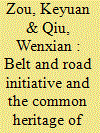

|
|
|
|
|
| Summary/Abstract |
With the development of global science and technology, the international legal concept of “the common heritage of mankind” (CHM) encounters some dilemma in practice. This editorial comment attempts to discuss the ongoing developments of the CHM concept in the context of the Belt and Road Initiative (BRI) put forward by China, and then the interplay between the two concepts. It is argued that the inherent elements of the CHM concept, such as co-management, co-benefit, and co-participation, are well reflected in the BRI. Moreover, the BRI can also reinforce the dynamic extension of the CHM concept in the above three key elements. As a new international public good, the BRI is aimed at reasonable allocation and sharing of international resources following the CHM concept, and correspondingly this concept can strengthen the theoretical basis of the BRI facilitating its entry into the centre of the international stage
|
|
|
|
|
|
|
|
|
|
|
|
|
|
|
|
| 5 |
ID:
164082
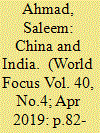

|
|
|
|
|
| Summary/Abstract |
China’s Belt and Road Initiative (BRI) is an ambitious project to connect Asia with Africa and Europe via land and maritime networks along six corridors with the aim of improving regional integration, increasing trade and economic growth. The term BRI was coined in 2013 by Chinese President Xi Jinping who drew inspiration from the old concept of the Silk Road established during the Han Dynasty 2000 years ago.
|
|
|
|
|
|
|
|
|
|
|
|
|
|
|
|
| 6 |
ID:
178215
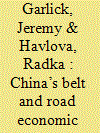

|
|
|
|
|
| Summary/Abstract |
Drawing on the literature on strategic hedging and adapting it to China’s use of economic diplomacy in the service of comprehensive national security goals within the regionalised foreign policy approach of the Belt and Road Initiative (BRI), we examine China’s approach to securing and expanding its interests in the Persian Gulf. To implement the trade and infrastructure connectivity goals of the BRI and to secure the continued flow of diversified energy supplies, China needs to boost relations with both regional powerhouses, Iran and Saudi Arabia, without alienating either of them or the regional hegemon, the United States. The resulting strategy of strategic hedging is based in the Chinese approach to economic diplomacy, which utilises Chinese commercial actors in the service of national strategic objectives. Relations require careful and ongoing management if China is to achieve outcomes which benefit all sides while avoiding becoming entangled in the region’s intractable geopolitical problems.
|
|
|
|
|
|
|
|
|
|
|
|
|
|
|
|
| 7 |
ID:
167817
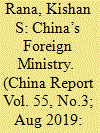

|
|
|
|
|
| Summary/Abstract |
President Xi Jinping has raised the bar in China’s engagement with the world: first, in launching in 2012 the ‘Belt and Road Initiative’ (BRI) as the idiom for intensive eco-political engagement with a wide swathe of states in Asia, Europe and Africa, plus Latin America; and second, in framing heightened global expectations for this self-avowed ‘major country’ that has moved out of the shadow of Deng Xiaoping’s 1989 hide our capacities and bide our time dictum. This places unprecedented demands on the foreign ministry, its diplomatic mission and personnel, and on all the other agencies that make up what we may call the foreign affairs network. The year 2018 has seen several new developments in the institutional structures and the work methods that connect with this enhanced priority to foreign policy implementation. This essay examines the challenges that China currently faces in pursuing its ambitious external objectives, in a fraught international environment and contestation among the world’s leading and emerging powers. Domestic challenges in coordinating actions are visible in BRI projects, which are a high national priority. The Chinese foreign ministry now receives better political support, but it remains unclear if this will suffice in meeting the major challenges they face, both abroad and at home—in working with domestic stakeholders.
|
|
|
|
|
|
|
|
|
|
|
|
|
|
|
|
| 8 |
ID:
193573
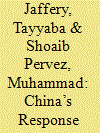

|
|
|
|
|
| Summary/Abstract |
In response to China’s phenomenal rise in the Indo-Pacific, the United States and its allies have institutionalized the QUAD. This article seeks to critique the novel construct of ‘Harmonious Realism’ and argues that the Chinese strategy for an Indo-Pacific regional order is paradoxical in nature. This paradox entails dichotomy between China’s rhetoric and practices in its institutional, strategic and economic aspects which can be empirically corroborated by the way China relates to ASEAN, its effort to seek an alternate model of security, and ensure economic interconnectivity through the BRI—all of which is counter-intuitive to China’s rhetoric of peaceful co-existence.
|
|
|
|
|
|
|
|
|
|
|
|
|
|
|
|
| 9 |
ID:
167327
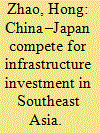

|
|
|
|
|
| Summary/Abstract |
As the two most significant Asian powers, competition in infrastructure sectors in Asia between China and Japan is inevitable. Japan is a long-established developer of regional infrastructure in Southeast Asia, while China’s interest in financing and building infrastructures there is relatively recent. After China proposed the Belt and Road Initiative (BRI) and the Asian Infrastructure Investment Bank (AIIB), Japan stepped up its efforts, determined to expand its already well-established influence. This competition has had positive as well as negative consequences for Southeast Asia and regional financial architecture. This article attempts to use Sino–Japanese competition for infrastructure financing and high-speed railway contracts as a case in point to explore in what ways and trajectory these two countries’ competition for infrastructure investment is going on, and what impacts it will create on the region.
|
|
|
|
|
|
|
|
|
|
|
|
|
|
|
|
| 10 |
ID:
158042
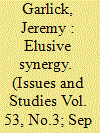

|
|
|
|
|
| Summary/Abstract |
In 2012, China and the European Union (EU) issued a joint declaration on energy security. It is unclear, however, what progress has been made since then in terms of applying the goals of the declaration. This paper sets out to assess the present state of China and the EU’s energy security, the potential for future cooperation, and the obstacles which stand in the way. The analysis assesses the extent to which the two actors can work together on improving energy infrastructure, diversifying supplies, and developing renewable and nuclear energy, possibly by finding synergies between China’s Belt and Road Initiative and the EU’s Juncker Plan. It also includes a re-examination of the concept of energy security to take account of the urgency of addressing the collapse of the global environment. Overall, the analysis suggests that although due to geographical and other constraints there may be limited opportunity for cooperation between the EU and China on securing oil and gas supplies, there are both scope and a pressing need for joint action in the field of renewable energy.
|
|
|
|
|
|
|
|
|
|
|
|
|
|
|
|
| 11 |
ID:
172829
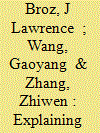

|
|
|
|
|
| Summary/Abstract |
We analyze the factors that increase the likelihood that other nations will follow China's global economic leadership. While our theoretical framework incorporates the conventional argument that China pulls in followers with economic benefits, we focus on grievances with the current global order that have the effect of pushing countries toward the rising new leader. We find that grievances about global financial instability are particularly important push factors. Our results show that countries that have experienced more financial crises, more variable capital account policies, more volatile portfolio capital outflows, and more social unrest during IMF programs are more likely to support China's global leadership than leaders of nations that have been less exposed to these problems. We find no evidence that grievances about global governance, or grievances about discriminatory US trade policies, are related to foreign support for China's global economic leadership. Overall, our evidence is consistent with the interpretation that leaders want to reform and preserve the WTO and the IMF, which have worked reasonably well for them under US leadership. At the same time, they have incentives to follow China's economic leadership on global capital flows, emphasizing long-term infrastructure and development finance over short-term flows which, under the current order, have imposed large costs on many economies.
|
|
|
|
|
|
|
|
|
|
|
|
|
|
|
|
| 12 |
ID:
185613
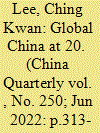

|
|
|
|
|
| Summary/Abstract |
The recent two-decade-long march of “global China” – manifested as outward flows of investment, loans, infrastructure, migrants, media, cultural programmes and international and civil society engagement – has left sweeping but variegated footprints in many parts of the world. From “going out,” officially announced in the year 2000, to the Belt and Road Initiative (BRI) and Made in China 2025, and from the developing world to advanced industrialized democracies, state-endorsed campaigns are but tips of a much more momentous iceberg. Numerous Chinese citizens and private corporations have also participated in a global search for employment, business, investment and educational and emigration opportunities. International reactions to the increasingly ubiquitous presence of China and the Chinese people in almost every corner of the world have evolved from a mixture of anxiety and hope to a more explicitly critical backlash. Terms such as “sharp power,” “debt-trap diplomacy” and the “new Cold War” bespeak the West's dominant perception today of China as a threat to be contained.
|
|
|
|
|
|
|
|
|
|
|
|
|
|
|
|
| 13 |
ID:
164776


|
|
|
|
|
| Summary/Abstract |
Iran is expected to be one of the main beneficiaries of China’s Belt and Road Initiative (BRI). China and Iran had a track record of cooperation long before the announcement of BRI, developing a highly asymmetric Great Power-Middle Power partnership over the course of three decades. This article asks whether BRI will enable China and Iran to transcend the limitations faced by most Great Power-Middle Power relationships on the basis of Iran’s enhanced strategic economic and geographic value. It is argued that while BRI could benefit from stronger China–Iran ties, Iran’s international posturing has proven a significant hindrance to China, highlighting that entrenched patterns of engagement in Great Power-Middle Power relations are not easily shifted, even in the face of immense economic incentives.
|
|
|
|
|
|
|
|
|
|
|
|
|
|
|
|
| 14 |
ID:
177924
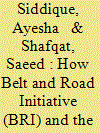

|
|
|
|
|
| Summary/Abstract |
A rising and globalizing China has evoked mixed reactions. There is a growing body of literature that highlights China's military hegemonic tendencies. This has overshadowed the Chinese efforts at promoting co-operative interdependence, of which the Belt and Road Initiative (BRI) is a symbol and emerging reality. This paper contextualizes the BRI, along with the China Pakistan Economic Corridor (CPEC), to examine and explore the symbols, tools and contours of the Chinese soft power. This study contends that, despite apprehensions by critics about China's motives underlying the BRI, for the participant countries it offers infrastructural development through economic investment and educational exchanges that showcase Chinese culture and its soft power. Do the participating countries find these offers appealing? This raises two critical questions: Does China's economic development oriented soft power through BRI obviates its military designs? Does China have the tools that Joseph Nye conceptualizes for the soft power that a global power requires? This study makes a critical appraisal of Joseph Nye's concept of Soft Power and analyses how the Chinese scholars and policy makers are transforming its usage and conceptual applicability as China stands for globalization, multilateralism, common and shared goals for the planet and humanity. Given COVID 19, China's soft power appeal could have political and security implications for the global world order.
|
|
|
|
|
|
|
|
|
|
|
|
|
|
|
|
| 15 |
ID:
169955


|
|
|
|
|
| Summary/Abstract |
This article is a conceptual review of identifying the factors of the successful implementation of Belt and Road Initiative (BRI) on small-medium enterprises (SMEs) in Malaysia. China’s president Xi Jin Ping has launched the China’s ‘One Belt One Road’ (OBOR) initiative or BRI in 2013. BRI focusses on the connectivity and cooperation between Asian, European and African continents economically and strategically through massive infrastructure developments, trades and investments. BRI is specified to two international trade connections: land-based ‘Silk Road Economic Belt’ and sea-based ‘21st Century Maritime Silk Road’. Malaysia is one of the Southeast Asia countries that actively participated in BRI. According to the World Bank, SMEs are almost 98.5 per cent of business establishments in Malaysia, which undoubtedly indicates how important SMEs are in Malaysia. As such, that is the question to ponder of how BRI could connect and associate with the enhancement and development of Malaysia’s SMEs. Therefore, the objective of the study is to identify the factors of the successful implementation of BRI on SMEs in Malaysia. Based on this study’s literature reviews, it would be suggested that new business and investment opportunity creations, connectivity and cooperation enhancement, trade and export boosting, geographic location and enhancement of e-commerce were the most critical factors in the successful implementation of BRI on SMEs in Malaysia.
|
|
|
|
|
|
|
|
|
|
|
|
|
|
|
|
| 16 |
ID:
185851
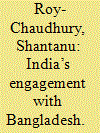

|
|
|
| 17 |
ID:
164107
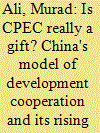

|
|
|
| 18 |
ID:
179942
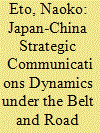

|
|
|
|
|
| Summary/Abstract |
Since the 2000s, the power of international narratives has attracted much attention in China. Under the Xi Jinping administration, the enhancement of "international discourse power" became an explicit policy and a diplomatic goal, closely linked to its Belt and Road Initiative (BRI). BRI, further, overlaps with China's efforts to develop a new concept of "institutional discourse power" as a mechanism to convert the economic gravity of China into political power by enhancing their agenda-setting capability, particularly in emerging rule-making process of the new economy. Such ambition has also shaped the new economic integrative framework between China and developed countries including Japan. Japan, on the other hand, relied on an increasingly inclusive notion of free and open Indo-Pacific (FOIP) to define and promote its relations with both "likeminded countries" and China for the purpose of making the BRI relative. Although Japan and China have agreed on economic cooperation in third countries as a new collaborative scheme in 2018, there remains a gap in their political objectives and strategic communications. This poses a major challenge for China, which hitherto has relied on China-centric narratives, as it can only enhance its identity as a global leading power by accommodating and accepting partially narratives of other major countries, including Indo-Pacific countries.
|
|
|
|
|
|
|
|
|
|
|
|
|
|
|
|
| 19 |
ID:
164764


|
|
|
|
|
| Summary/Abstract |
Beijing’s ambitious Belt and Road Initiative (BRI) has exacerbated a longstanding concern about the power shift from the West to China. The existing debate, however, is both motivated by, and fixated on, the strategic concerns of and about great powers (and to a lesser extent, middle powers). What is often overlooked is the concerns and voices of smaller countries and contested regions where some of the power-shift symptoms allegedly unfold, such as the South Pacific. To traditional donors such as Australia, the power dynamism in the South Pacific is largely a linear, two-way model of power shift from Western donors to Beijing. Challenging this model, this article proposes a complex, three-way model to bring small and seemingly passive actors into the power shift equation. To illustrate, the article uses Papua New Guinea’s (PNG) perceptions of China’s aid vis-à-vis Australia’s aid as a case study. Relying mostly on primary (interview) sources, this study not only reveals some nuanced attitudes of local actors toward the great-power interactions, but also highlights the hitherto neglected role and agency of Pacific Island nations and their domestic politics in the inherently complex power shifts.
|
|
|
|
|
|
|
|
|
|
|
|
|
|
|
|
| 20 |
ID:
188353
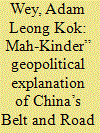

|
|
|
|
|
| Summary/Abstract |
China’s Belt and Road Initiative (BRI) has garnered a lot of attention, and worries about its impact and influence over Eurasia and Indo-Pacific. Two classical geopoliticians – Halford J. Mackinder and Alfred Thayer Mahan – had provided useful frameworks to explain China’s BRI geopolitical implications, and geostrategies to dominate the Eurasian continent and Indo-Pacific waterways with economic tools and infrastructure projects. This article claims that China’s BRI is a testament of the exceptional explanatory power of classical geopolitical theories in the practice of grand strategy in international politics.
|
|
|
|
|
|
|
|
|
|
|
|
|
|
|
|
|
|
|
|
|